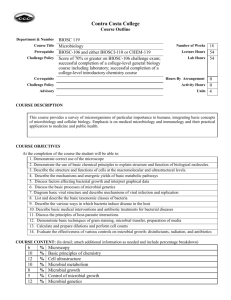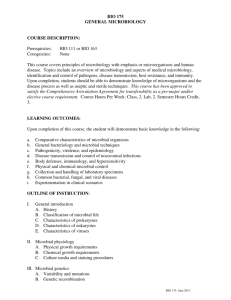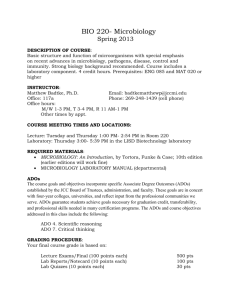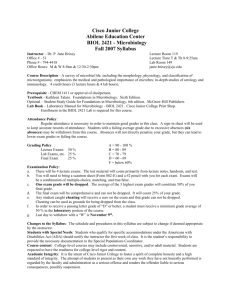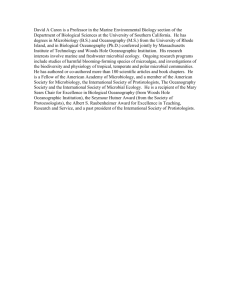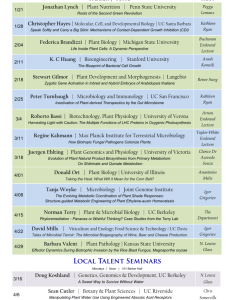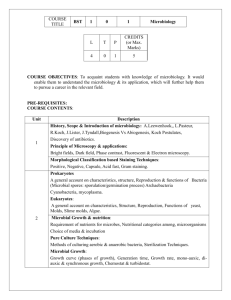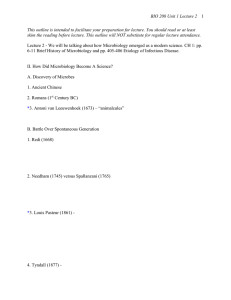Bio 215 Microbiology Syllabus & Course
advertisement
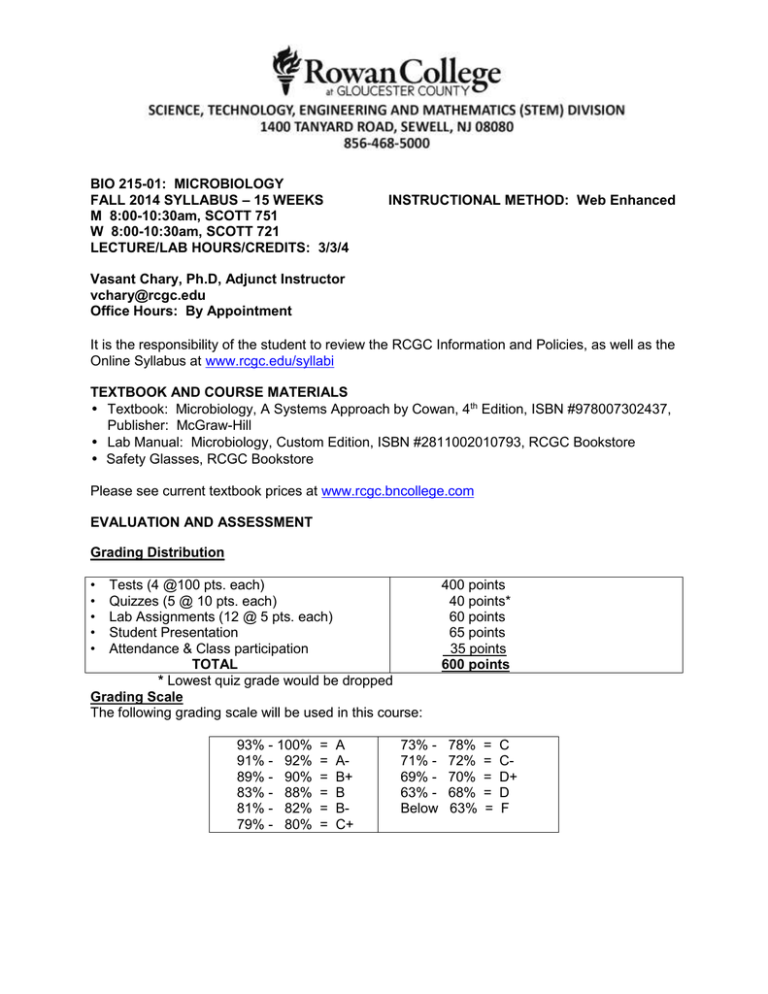
BIO 215-01: MICROBIOLOGY FALL 2014 SYLLABUS – 15 WEEKS M 8:00-10:30am, SCOTT 751 W 8:00-10:30am, SCOTT 721 LECTURE/LAB HOURS/CREDITS: 3/3/4 INSTRUCTIONAL METHOD: Web Enhanced Vasant Chary, Ph.D, Adjunct Instructor vchary@rcgc.edu Office Hours: By Appointment It is the responsibility of the student to review the RCGC Information and Policies, as well as the Online Syllabus at www.rcgc.edu/syllabi TEXTBOOK AND COURSE MATERIALS • Textbook: Microbiology, A Systems Approach by Cowan, 4th Edition, ISBN #978007302437, Publisher: McGraw-Hill • Lab Manual: Microbiology, Custom Edition, ISBN #2811002010793, RCGC Bookstore • Safety Glasses, RCGC Bookstore Please see current textbook prices at www.rcgc.bncollege.com EVALUATION AND ASSESSMENT Grading Distribution • • • • • Tests (4 @100 pts. each) Quizzes (5 @ 10 pts. each) Lab Assignments (12 @ 5 pts. each) Student Presentation Attendance & Class participation TOTAL * Lowest quiz grade would be dropped Grading Scale The following grading scale will be used in this course: 93% - 100% 91% - 92% 89% - 90% 83% - 88% 81% - 82% 79% - 80% = = = = = = A AB+ B BC+ 73% 71% 69% 63% Below 400 points 40 points* 60 points 65 points 35 points 600 points 78% 72% 70% 68% 63% = = = = = C CD+ D F 2 BIO 215 CORE COMPETENCIES This course focuses on two of RCGC’s Core Competencies: • Scientific Knowledge and Reasoning • Quantitative Knowledge and Skills STUDENT LEARNING OUTCOMES: BIO 215: MICROBIOLOGY Successful completion of BIO 215 will help students: RCGC Core Competencies Evaluation / Assessment 1. Distinguish among the various groups of microorganisms within the microbial world. - Scientific Knowledge and Reasoning - Exams 2. Develop the skills of handling, observing, culturing and staining microorganisms. - Scientific Knowledge and Reasoning - Laboratory assignments 3. Describe the main characteristics of bacteria, including their morphology, growth, reproduction and classification. - Scientific Knowledge and Reasoning - Quantitative Knowledge and Skills - Exams - Quizzes 4. Understand and apply methods of microbial control that can be used to prevent both the transmission of infectious diseases and the spoilage of foods. - Scientific Knowledge and Reasoning - Quantitative Knowledge and Skills - Exams - Quizzes - Laboratory assignments 5. Understand and describe the fundamental principles of the hostparasite relationship both in health and disease. - Scientific Knowledge and Reasoning - Quantitative Knowledge and Skills - Exams - Quizzes - Laboratory assignments 6. Describe the components of the human immune system and understand how these components interact in generating an immune response. - Scientific Knowledge and Reasoning - Quantitative Knowledge and Skills - Exams - Quizzes - Laboratory assignments COURSE POLICIES ATTENDANCE – Students attain maximum academic benefit through regular class attendance. Therefore, students are expected to attend all class sessions for which they are scheduled. Attendance will be recorded. If you miss a class, it is your responsibility to make up all material missed. You should make arrangements with someone who attended the class to get copies of handouts and notes. EXAMS/QUIZZES – Exams and quizzes will be based on lecture notes, laboratory exercises, assigned textbook reading and handout sheets and could include multiple choice and essay 3 questions. The student is responsible for assigned textbook readings to prepare you for tests and quizzes. MAKE UP POLICY – There are no make-ups for exams or quizzes. PARTICIPATION AND ARTICLES – Students may elect to find articles regarding current topics in the news pertaining to any microbiology issue. Students will bring in the article(s) and be able to discuss the article with the class. Students can do this two times during the semester in order to receive +5 points each extra credit. These articles can be found in local papers, on the web, etc. STUDENT PRESENTATIONS – All students are required to present a formal PowerPoint presentation on a disease found in chapters 18-23 of the Microbiology textbook. Presentations will occur over several class periods at the end of the semester. Students may work individually or in groups of 2 but each student must present a portion of the lecture. A schedule with topics to choose from and a list of the required elements are posted on eLearning listed under “student presentations.” ACADEMIC INTEGRITY – In cases of cheating, plagiarism and/or fabrication, faculty have the authority to impose an academic sanction that is reasonable and commensurate with the violation (Rules and Regulations #R-8019). Students will receive grade of “0” for cheating violation. Make sure you reference your sources of information, including internet sources. ELECTRONICS – Use of cell phones, MP3 players, pagers, and similar electronic devices is not permitted during class time. Approval must be gained from the instructor prior to student use of audio or video recording devices in class. BIO 215 MICROBIOLOGY SYLLABUS 1. Introduction to Microbiology – Science of Microbiology, Microbial Cells. Evolution and Extent of Microbial cells. Pathways of Discovery in Microbiology (Contributions of Leeuwenhoek, Pasteur, Koch etc.,). Overview of microbial Diversity. Modern era of Microbiology. 2. Cell Structure and Function (Cell Shape and Size, Cytoplasmic membrane and transport, Cell Walls of Prokaryotes, Cell surface structures, Microbial locomotion. 3. Microbial Metabolism. Nutrition and culture of microorganisms. Essentials of Catabolism (Aerobic vs Anaerobic respiration vs Fermentation) 4. Microbial growth. Dynamics of bacterial growth and measurement. 5. Control of Microbial growth (Selection of Antimicrobial procedures. Heat, Chemical and Physical methods of growth control). 6. Antimicrobial agents. Antibiotics. Mode of action of antibiotics and mechanisms of antibiotic resistance. Determinations of MIC & Susceptibility testing) 7. Viruses and Virology. Virus Structure and Growth. Viral replication. Overview of bacterial viruses. T2 and Temperate bacteriophages, Lambda. 8. Microbial interactions with humans – An overview. Normal micro flora of Skin, Oral cavity, GI and other body regions. 9. Microbial virulence and Pathogenesis. Host microbe interactions. Mechanism of Pathogenesis Invasion, colonization and infection. Exotoxins and Endotoxins. 4 10. Immunology. Immunity and Host Defense. Innate and Acquired immunity. Antigen and Antibody – Structure and function. 11. Applications of Immune Response (Vaccines and Immunization Procedures). 12. Microbial diseases. Important human diseases caused by microorganisms. For eg: Skin & Wound infections caused by Bacteria and Viruses. Respiratory infections by bacteria and Viruses. Diseases of the digestive system. Sexually transmitted diseases. Vector-borne microbial pathogens. Human diseases caused by Protozoa and Fungi. Emphasis would be on microorganism involved, mode of transmission, prevention and control. LECTURE NOTES Lecture outlines and other class materials are available on my webpage: https://drvasantchary.wikispaces.com. Instructions to open and download the lecture file from the Weblink 1. 2. 3. 4. Web link: https://drvasantchary.wikispaces.com/ Click ‘Pages and Files’ menu present on the top right hand side. Single click on any of the Files you need. - A new Window opens Click ‘download’ button present on the top right hand side. DOWNLOAD NOTES A DAY BEFORE LECTURE CLASS. The lectures are PowerPoint presentations, so you will need to select from the Format option when printing them out. Most students prefer either the Outline Format or the Handouts Format. With the Handouts format, specify 3 slides per page and you will get lines to write notes on. If you do not select an option, the notes will print out as 1 slide per page and this is not a very useful format. Lecture and lab notes will also be posted on the Wikispaces web site for your reference. HOW TO SUCCEED IN BIO 215- MICROBIOLOGY: 1. Plan study time into your schedule! You will need 6-8 hours of study time per week. I think it is more effective to do several shorter study sessions per week rather than one very long weekly study session. The main idea to keep in mind is that science is not a subject that can be learned by trying to read five chapters the day before the exam. 2. What to study: You will need to coordinate lecture and text materials as you study and do the review questions at the end of each chapter. Most students need to read each chapter twice to really understand and remember the material. Don’t forget to study the Figures in the text. Use “chapter key word” and “outline” files posted on the Canvas website to take notes while you read. 3. When to study: I’d strongly recommend that you come prepared for the class by reading the material a day before the lecture class. You may not understand everything, but that is fine. By reading beforehand you become familiar with certain terms and concepts that would greatly help you in understanding them in depth during the class. Write down some questions that you would like to discuss during the class as it would help you actively participate during classroom discussions. This is called active learning process that would be included for a portion of grading. 5 4. Find your own best study technique: use flashcards, draw diagrams if you are a visual learner, record and listen to your notes if you remember what you hear. Make studying more social by forming study groups. LECTURE SCHEDULE* Date Topic Reading Chapters Section 1: Cell Structure and Function Sept.03 (W) Introduction into the Course Chapter 1 (W) Sept.08 (M) The Themes of Microbiology Chapter 1 Sept.10 (W) Biomolecules - The Chemistry of Biology Chapter 2 Sept.15 (M) Prokaryotic Cell – Part 1 Chapter 3 Sept.17 (W) Prokaryotic Cell – Part 2 Chapter 3 Sept.22 (M) Eukaryotic Cell Chapter 4 Sept.24 (W) Buffer day** & Review day for the Unit 1 Exam ---Sept.29 (M) No Class on this day ---Section II: Microbial Growth, Metabolism & Viruses Oct.01 (W) Section II EXAM ---Oct.06 (M) Methods of Culturing Microorganisms Chapter 5 Oct.08 (W) Microbial Nutrition Chapter 7 Oct.13 (M) Microbial Growth Chapter 7 Oct.15 (W) Metabolism Chapter 8 Oct.20 (M) Viruses – Part 1 Chapter 6 Oct.22 (W) Viruses – Part 2 Chapter 6 Oct.27 (M) Buffer day** & Review day for the Unit 2 Exam ---Oct.29 (W) College Day classes - Closed ---Section III: Microbial Control, Antibiotics & Host defense mechanisms Nov.03 (M) Section III EXAM ---Nov.05 (W) Microbial Control - Physical & Chemical Chapter 11 Nov.10 (M) Principles of Chemotherapy Chapter 12 Nov.12 (W) Microbe-Human Interactions Chapter 13 (Antibiotics and Drug -resistance) Nov.17 (M) Host defense mechanisms Specific & NonChapter 14 Nov.19 (W) Host defense mechanisms Chapter 14 specific - Specific & NonNov.24 (M) Buffer day** & Review specific day for the Unit 3 Exam ---Nov.26 (W) Section III Exam ---Section IV: Immunology and Infectious Diseases Dec.01 (M) Immunity: Steps 1 and 2 Chapter 15 Dec.03 (W) Immunity: Steps 3 and 4 (Immunization) Chapter 15 Dec.08 (M) Human Infectious diseases – Part 1 Chapters 16-23 Dec.10 (W) Human Infectious diseases – Part 2 Chapters 16-23 Dec.15 (M) Buffer day** & Review day for the Final Exam ---Dec.17 (W) Section IV - FINAL EXAM ---* This schedule is tentative. Some lecture classes may not be covered on the days specified. ** Buffer day is used for completion of any incomplete lecture class. It would also be used for review of the completed chapters for the unit test that follows 6 LABORATORY OUTLINE I. II. III. IV. All lab experiments are held on Wednesdays of the week except for Oct 27th which would be held on Monday of that week Laboratories will be completed and handed in the day they are completed in their entirety. Students may work in groups of 3-4 and should remain lab partners for the semester, as you will be sharing lab equipment The following labs will be covered during this semester (see calendar) DATE LAB/EXP NUMBER 10th Sept. 1&2 17th Sept. 3&4 th LAB EXPERIMENT Introduction to Laboratory Safety & Microscopy Examining Live and Fixed Bacterial Preparations Simple Staining, Negative Staining 24 Sept. 5&6 1st Oct 7&8 8th Oct. 9 Gram Staining and Acid-Fast Staining Streak Plate & Spread Plate Technique/ Culturing Microorganisms Chemical Agents of Microbial Control 27th Oct** 5th Nov. 12th Nov. 10 11 12 Protista, Fungus and Worms Epidemiology Simulation and Lab 12 swab distribution Contaminants at home 19th Nov. 13 Identify Disease - Bacterial DNA ** Lab on Monday – FOR THIS WEEK ONLY 7 STUDENT LABORATORY RULES 1. Equipment location will be identified for students by the instructor. 2. Students will be assigned microscopes and stain kits to use for the duration of the semester. Students are responsible for taking care of equipment and are to report any damage to the instructor immediately. 3. Food and beverages are not permitted on the lab benches. 4. All tables to be cleaned up at the end of each laboratory session. All wastes must be properly disposed of; i.e., paper towels in wastebasket. 5. All chairs to be put in place under table when leaving. 6. Each student shall have the responsibility for the cleanliness and maintenance of the laboratories within the framework of mutual respect and professional ethics. 7. Absences from a lab counts as an overcut in the course. No make-up labs are available by which the absence can be erased. The student is still responsible for course content covered by the lab that was missed. 8. BEFORE YOU LEAVE THE LAB: a. Be sure the class is officially excused. b. Store your microscope properly. c. Return other materials, if any, to proper storage, as directed. (If you are not sure-ASK!) d. Clean tabletop completely (E. alcohol). Wipe down the counter with a damp paper towel. e. Push lab chair under the table at your place. 8 RUBRIC FOR ASSESSING PRESENTATIONS Introduction to Topic Explanation of Scientific Studies D Beginning or Incomplete Very little background information provided or information is incorrect No primary research explained or noncredible unscientific research sources. C Developing B Accomplished A Exemplary Some introductory Introduction is nearly information, but complete, missing still missing some some minor points major points Introduction complete and wellwritten; provides all necessary background principles for the talk. Primary research studies are presented but many are misstated, indicating a lack of understanding or studies are not explained in an interpretable manner to the rest of the class. Study results have been interpreted correctly and discussed, good understanding of results is conveyed All important conclusions have been drawn from studies, could be better stated Score All important conclusions have been clearly made, individual shows good understanding. Some studies mentioned but briefly and not explained. Oral Communication Presentation is rough and incomplete. Presentation is confusing and difficult to follow. Presentation follows a logical progression but could be improved. Audience had difficulty understanding. All information communicated well and understood by audience. PowerPoint Sections difficult Appearance and to follow, formatting Presentation does not make sense. Slides can be read but with difficulty. Slides do not help audience follow along. Slides are readable but could still be improved as a more effective visual aid. All slides are wellformatted and very readable. Easy to follow References Sited Sources not properly sited and less than 3 scientific resources Three or more scientific sources but not properly sited Three or more scientific sources properly sited No references sited Total Score: _______
